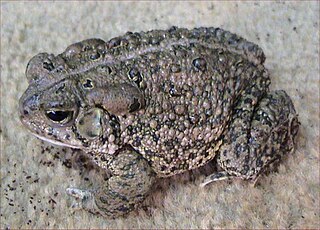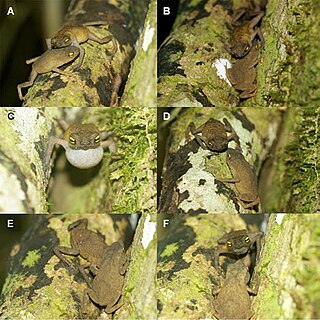Related Research Articles

James Ray Dixon was professor emeritus and curator emeritus of amphibians and reptiles at the Texas Cooperative Wildlife Collection at Texas A&M University. He lived in El Campo, Texas, throughout most of his childhood. He published prolifically on the subject of herpetology in his distinguished career, authoring and co-authoring several books, book chapters, and numerous peer reviewed notes and articles, describing two new genera, and many new species, earning him a reputation as one of the most prominent herpetologists of his generation. His main research focus was morphology based systematics of amphibians and reptiles worldwide with emphasis on Texas, US, Mexico, Central America, and South America, although bibliographies, conservation, ecology, life history and zoogeography have all been the subjects of his extensive publications.
Truebella is a genus of small true toads, family Bufonidae. It is endemic to the Ayacucho and Junín Regions of Peru. The generic name honors Linda Trueb, an American herpetologist.

Woodhouse's toad is a medium-sized true toad native to the United States and Mexico. There are three recognized subspecies. A. woodhousii tends to hybridize with Anaxyrus americanus where their ranges overlap.

Helen Beulah Thompson Gaige was an American herpetologist, curator of Reptiles and Amphibians for the Museum of Zoology at the University of Michigan, and a specialist in neotropical frogs.

Frostius – known as Frost's toads – is a small genus of true toads consisting of only two species endemic to Brazil. The genus was proposed by David C. Cannatella in 1986 based on an analysis of a species previously classified as Atelopus. Various morphological and life-history information first suggested that it is sister taxon to Atelopus or Atelopus + Osornophryne, but later molecular evidence suggests that it is sister taxon to Oreophrynella. It was named for Darrel Frost in recognition of his work on anuran systematics.
Atelopus lynchi, also known as Lynch's stubfoot toad or Lynch's harlequin frog, is a species of toad in the family Bufonidae. It occurs in northern Ecuador (Carchi) and in southern Colombia. It occurs on the Pacific slope of the Cordillera Occidental, as the westernmost ranges of the Andes are known in both Colombia and in Ecuador. Prior to its description, it was confused with Atelopus longirostris.

James Arthur Peters was an American herpetologist and zoogeographer.

The Salientia are a total group of amphibians that includes the order Anura, the frogs and toads, and various extinct proto-frogs that are more closely related to the frogs than they are to the Urodela, the salamanders and newts. The oldest fossil "proto-frog" appeared in the early Triassic of Madagascar, but molecular clock dating suggests their origins may extend further back to the Permian, 265 million years ago.

The Eastern Cordillera Real montane forests (NT0121) is an ecoregion in the eastern range of the Andes of southern Colombia, Ecuador and northern Peru. The ecoregion covers the eastern slopes of the Andes, and includes montane forest that rises from the Amazonian rain forest, with cloud forest and elfin forest at higher elevations. It is rich in species, including many endemics. It is threatened by logging and conversion for pasturage and subsistence agriculture.

María Cristina Ardila-Robayo was a Colombian herpetologist. She was professor at the National University of Colombia, Bogotá, and worked closely with the Natural History Museum of the university. In 2010 she was credited as having described 28 new species of amphibians from Colombia; as of late 2018, the Amphibian Species of the World lists 31 valid species described by her. She also worked with caimans and crocodiles and lead biodiversity restoration projects.
Linda Trueb is an American professor of herpetology and systematics biology at the University of Kansas and a senior curator emerita at the university's Biodiversity Institute. She also acts as the associate director for the Institute's Administration and Research department.